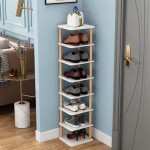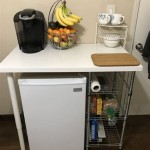```html
Maximizing Clothes Storage Without a Closet System
Many individuals face the challenge of limited closet space, particularly in older homes or smaller apartments where built-in closet systems are absent or inadequate. The lack of a conventional closet, however, does not necessitate a life of perpetually overflowing drawers and clothes piled on chairs. Creative solutions, utilizing readily available and affordable resources, can effectively maximize clothes storage even without a dedicated closet system. These methods focus on optimizing existing space, employing vertical storage strategies, and repurposing furniture to accommodate clothing items.
The key to successful closet-less storage lies in meticulous planning and a commitment to decluttering. Before implementing any storage solution, a thorough assessment of the current wardrobe is essential. This entails identifying items that are no longer worn, are damaged beyond repair, or are unsuitable for the current climate. Donating, selling, or discarding these items immediately reduces the volume of clothing that requires storage. Furthermore, organizing clothing into categories, such as type of garment (shirts, pants, dresses) and season, facilitates efficient storage and retrieval.
Once the wardrobe has been streamlined, the available space must be critically evaluated. This includes measuring the dimensions of rooms and identifying areas that can be repurposed for clothing storage. Vertical space is often underutilized and presents a significant opportunity for maximizing storage capacity. Understanding the layout of the room and the types of clothing to be stored will inform the selection of appropriate storage solutions.
Utilizing Vertical Space with Garment Racks and Shelving Units
One of the most effective methods for storing clothes without a closet system is the use of garment racks. Garment racks come in various styles and sizes, ranging from simple freestanding racks to more elaborate models with multiple tiers and shelving. The type of garment rack selected should be based on the amount of clothing to be stored and the available space. For heavier items, such as coats and jackets, a sturdier rack with a higher weight capacity is recommended. For lighter items, such as shirts and blouses, a lighter-duty rack may suffice.
When positioning a garment rack, consider its proximity to other furniture and walkways. Ensure that there is adequate space to move around the rack without obstruction. Utilizing the space above the rack can further enhance storage capacity. Shelves can be installed above the rack to store folded items, shoes, or accessories. Alternatively, hanging organizers can be suspended from the rack to provide additional storage for smaller items such as scarves, belts, and socks.
Shelving units provide another versatile solution for storing clothes without a closet. Open shelving units allow for easy visibility and access to clothing, while closed shelving units with doors or drawers offer a more concealed and organized appearance. The choice between open and closed shelving depends on personal preference and the desired aesthetic. When selecting a shelving unit, consider its dimensions and the weight capacity of each shelf. Heavier items, such as sweaters and jeans, should be stored on lower shelves to prevent instability.
Shelving units can be strategically placed in various locations throughout the room, such as along walls, in corners, or even as room dividers. When using shelving units as room dividers, ensure that they are securely anchored to the floor or wall to prevent them from tipping over. Similar to garment racks, the space above shelving units can be utilized for additional storage. Baskets or bins can be placed on top of the shelves to store out-of-season clothing or other items.
Repurposing Furniture and Utilizing Under-Bed Storage
Existing furniture can be repurposed to provide additional clothing storage. Dressers, chests of drawers, and armoires are traditionally used for storing clothes, but their functionality can be expanded with the addition of organizers and dividers. Drawer organizers can help to keep clothes neatly folded and separated, maximizing space and preventing clutter. Dividers can be used to separate different types of clothing within the same drawer, making it easier to find specific items.
The tops of dressers and chests of drawers can also be utilized for storage. Decorative boxes or trays can be placed on top of these furniture pieces to store accessories, jewelry, or other small items. A leaning ladder can be placed against the wall next to a dresser or chest of drawers to provide additional hanging space for scarves, belts, or necklaces.
Under-bed storage is often overlooked but can provide a significant amount of space for storing clothes, particularly out-of-season items. Under-bed storage containers come in various sizes and materials, ranging from simple plastic bins to more elaborate models with wheels and handles. The type of container selected should be based on the size of the bed and the type of clothing to be stored. For delicate items, such as sweaters and dresses, a container with a lid is recommended to protect them from dust and moths.
When using under-bed storage, it is important to label the containers clearly so that the contents can be easily identified. Rotate the contents of the containers seasonally, storing out-of-season clothing underneath the bed and bringing in-season clothing to the forefront of the wardrobe.
Creative DIY Storage Solutions and Space-Saving Techniques
For individuals seeking more personalized and cost-effective storage solutions, DIY projects can provide a viable option. Wall-mounted clothes rails can be constructed using readily available materials such as plumbing pipes or wooden dowels. These rails can be customized to fit the specific dimensions of the room and the amount of clothing to be stored. Hanging organizers can be created from fabric scraps or repurposed materials such as old t-shirts or pillowcases. These organizers can be used to store shoes, accessories, or other small items.
Space-saving techniques are essential for maximizing storage capacity in small spaces. Rolling clothes is a space-saving technique that involves tightly rolling clothing items instead of folding them. This technique can significantly reduce the amount of space required to store clothes in drawers or bins. Vacuum-sealed bags can be used to compress bulky items such as comforters, blankets, and winter coats. These bags remove air from the items, reducing their volume by up to 75%.
Hanging clothes vertically can save space compared to folding them. Utilize slimline hangers to maximize the number of clothes that can be hung in a given space. Consider using cascading hangers, which allow multiple garments to be hung from a single hanger. These hangers are particularly useful for storing skirts, pants, or scarves.
By implementing these strategies, individuals can effectively maximize their clothes storage capacity without relying on traditional closet systems. Careful planning, decluttering, and creative utilization of available space are key to achieving an organized and functional wardrobe, regardless of the presence or absence of a built-in closet.
```
25 Best Clothes Storage Ideas For Small Bedrooms

12 No Closet Clothes Storage Ideas
12 Smart Ways To Organize Clothes Without A Dresser

12 No Closet Clothes Storage Ideas

12 No Closet Clothes Storage Ideas

Clothes Storage Ideas With No Dresser Organized 31

Clothes Storage Ideas 19 For Small Spaces Reader S Digest

9 Smart Strategies To Get More Out Of Your Small Closet Storage Space

12 Bedroom Organization With No Closet Ideas

Small Closet Organization Pt 2 Decluttering And My Ideas To Maximize Storage Life S Ahmazing
Related Posts








